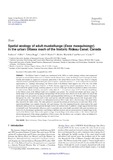| dc.contributor.author | Gillis, Nathan C. | |
| dc.contributor.author | Rapp, Tobias | |
| dc.contributor.author | Hasler, Caleb T. | |
| dc.contributor.author | Wachelka, Hedrik | |
| dc.contributor.author | Cooke, Steven J. | |
| dc.date.accessioned | 2020-06-08T20:48:19Z | |
| dc.date.available | 2020-06-08T20:48:19Z | |
| dc.date.issued | 2010-07-19 | |
| dc.identifier.citation | Gillis, Nathan C., Tobias Rapp, Caleb T. Hasler, Hedrik Wachelka, and Steven J. Cooke. "Spatial ecology of adult muskellunge (Esox masquinongy) in the urban Ottawa reach of the historic Rideau Canal, Canada." Aquatic Living Resources 23 (2010): 225-230. DOI: http://dx.doi.org/10.1051/alr/2010019. | en_US |
| dc.identifier.issn | 0990-7440 | |
| dc.identifier.uri | http://hdl.handle.net/10680/1813 | |
| dc.description.abstract | The Rideau Canal in Canada was constructed in the 1800s to enable strategic military and commercial transport in eastern Ontario between Lake Ontario and the Ottawa River. Today, the Rideau Canal is managed by Parks Canada and remains an engineered ecosystem, particularly in the urban Ottawa reach (7 km long) where it is largely channelized and is partially drained during the winter to protect canal infrastructure (i.e., locks) and provide recreational opportunities (i.e., skating). Interestingly, the Ottawa reach of the Rideau Canal supports one of the few wild urban muskellunge (Esox masquinongy) fisheries in North America supported by natural reproduction. However, little is known about the spatial ecology, residency patterns or survival of this apex freshwater predator in urban environments or canal systems. Radio-telemetry was used to study adult (N = 10; total size range of 64 to 122 cm) muskellunge in the Ottawa reach of the Rideau Canal over a multiple year period. The seasonal movements and home range of muskellunge were greatest during spring corresponding with the period when water levels in the canal were raised and muskellunge were presumably seeking out suitable spawning habitats following ice-off. During the summer fish ranged throughout the entire 7 km urban reach of the canal and by early fall muskellunge moved to the deeper parts of the reach and became largely restricted to an embayment known as Dow’s Lake prior to the lowering of the canal where they stayed for the entire winter. The same pattern of seasonal movements persisted across several years. None of the tagged muskellunge were stranded from the fall canal drainage. One fish emigrated from the urban reach of the canal during the study period, moving upstream through a lock to an exurban reach. In addition, a single tagged fish died from a winterkill event. Environmental influences such as seasonality and water depth (associated with canal operations) are believed to be the primary mechanisms contributing to habitat selection and movement patterns of muskellunge in this reach of the Rideau Canal. Data on the spatial ecology of muskellunge in the urban reaches of the Rideau Canal will inform management of this unique population of fish to ensure that the historic and ecological values are balanced to preserve this iconic Canadian natural heritage site and its biota. | en_US |
| dc.description.sponsorship | "The authors would like to thank the Ottawa Chapter of Muskies Canada for the funding and field assistance provided during this study." | en_US |
| dc.description.uri | https://www.alr-journal.org/articles/alr/abs/2010/02/alr012-10/alr012-10.html | en_US |
| dc.language.iso | en | en_US |
| dc.publisher | EDP Sciences | en_US |
| dc.rights | info:eu-repo/semantics/openAccess | en_US |
| dc.subject | Radio-telemetry | en_US |
| dc.subject | Home Range | en_US |
| dc.subject | Seasonal Behaviour | en_US |
| dc.subject | Esocidae | en_US |
| dc.title | Spatial ecology of adult muskellunge (Esox masquinongy) in the urban Ottawa reach of the historic Rideau Canal, Canada | en_US |
| dc.type | Article | en_US |
| dc.identifier.doi | 10.1051/alr/2010019 | en_US |

